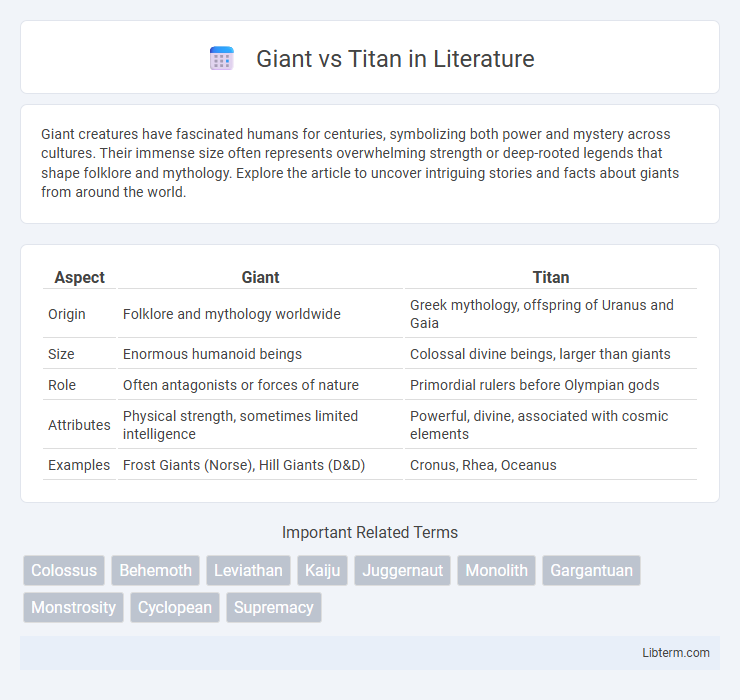Giant creatures have fascinated humans for centuries, symbolizing both power and mystery across cultures. Their immense size often represents overwhelming strength or deep-rooted legends that shape folklore and mythology. Explore the article to uncover intriguing stories and facts about giants from around the world.
Table of Comparison
| Aspect | Giant | Titan |
|---|---|---|
| Origin | Folklore and mythology worldwide | Greek mythology, offspring of Uranus and Gaia |
| Size | Enormous humanoid beings | Colossal divine beings, larger than giants |
| Role | Often antagonists or forces of nature | Primordial rulers before Olympian gods |
| Attributes | Physical strength, sometimes limited intelligence | Powerful, divine, associated with cosmic elements |
| Examples | Frost Giants (Norse), Hill Giants (D&D) | Cronus, Rhea, Oceanus |
Introduction: Defining Giants and Titans
Giants and Titans are mythological beings often depicted as massive and powerful figures in ancient lore. Giants usually appear in various cultures as humanoid creatures of great strength and size, while Titans originate specifically from Greek mythology, representing a primordial race of deities who preceded the Olympian gods. Understanding their distinct origins and roles highlights their significance in mythological narratives and cultural symbolism.
Historical Origins: Myths and Legends
Giants and Titans originate from distinct mythological traditions, with Giants primarily rooted in Norse and Greek myths as massive beings symbolizing chaos and primal forces. Titans, specifically from Greek mythology, are primordial deities who ruled before the Olympian gods, embodying fundamental aspects of the cosmos. Historical legends portray Giants as adversaries of gods and humans, while Titans represent ancestral divine power, often depicted in epic battles shaping the world order.
Physical Characteristics: Size and Strength
Giants and Titans both exhibit immense physical characteristics, but Titans are generally depicted as larger and more robust entities, often towering over Giants in size. Giants possess considerable strength, yet Titans surpass them with extraordinary power, often linked to mythological narratives where Titans hold dominion over natural forces. The sheer scale and muscular build of Titans emphasize their dominance in ancient lore, highlighting a distinct difference in physical prowess compared to Giants.
Cultural Representations in Literature
Giants and Titans in literature often symbolize overwhelming power and primal forces of nature, with Titans rooted in Greek mythology as primordial deities challenging the Olympian gods. Giants frequently appear in folklore and fairy tales, representing formidable but often brutish adversaries, such as the giant in "Jack and the Beanstalk" or the Norse Jotunn. Literary portrayals contrast Titans' majestic, cosmic scale with Giants' earthy, monstrous embodiment, reflecting cultural perceptions of divine vs. chaotic strength.
Symbolism and Meaning Across Civilizations
Giants often symbolize chaos and the primal forces of nature in mythology, representing humanity's struggle against overwhelming odds, while Titans are seen as embodiments of primordial power and cosmic order, particularly in Greek mythology where they signify the old gods' might before being overthrown by the Olympians. Across civilizations, giants embody raw, untamed strength and the fear of the monstrous unknown, often serving as adversaries or creators in folklore. Titans, by contrast, frequently symbolize foundational cosmic structures and the cyclical nature of divine authority, reflecting themes of succession and transformation in mythic narratives.
Key Battles: Iconic Clashes in Mythology
The Titanomachy stands as the seminal battle between Titans and Giants, where the Olympian gods triumphed over the elder Titans, reshaping cosmic order in Greek mythology. The Gigantomachy, a fierce conflict between Giants and Olympian deities, epitomizes the struggle for divine supremacy, featuring heroes like Heracles aiding the gods. These iconic battles symbolize the eternal clash between chaos and order, underscoring themes of power, rebellion, and cosmic hierarchy in ancient mythological narratives.
Powers and Abilities Compared
Giants possess immense physical strength, towering size, and enhanced durability, allowing them to dominate in brute force combat and withstand heavy attacks. Titans exhibit supernatural abilities like regeneration, elemental control, and powerful energy projection, making them formidable beyond mere physicality. The comparison highlights that while giants excel in raw physical power, titans combine that with versatile, often magical, capabilities for a broader range of combat scenarios.
Giants and Titans in Modern Pop Culture
Giants and Titans dominate modern pop culture as symbols of immense power and mythical grandeur, appearing prominently in films, video games, and literature. Giants often embody brute strength and ancient folklore, while Titans are portrayed with cosmic significance and primordial origins, notably in franchises like "Attack on Titan" and Marvel's "Titan" characters. Their contrasting representations enrich storytelling by blending mythological themes with contemporary narratives, captivating global audiences.
Influence on Language and Expressions
The terms "giant" and "titan" have heavily influenced language and expressions by symbolizing immense size, strength, and power across cultures. "Giant" commonly appears in folklore and everyday speech to depict overwhelming force or stature, such as in phrases like "giant leap" or "thinking like a giant." "Titan" originates from Greek mythology, often used metaphorically in modern language to describe colossal impact or dominance, evident in expressions like "a titan of industry" or "titanic efforts.
Conclusion: Lasting Impact on Human Imagination
The enduring appeal of giants and titans lies in their symbolic representation of power, struggle, and the unknown within human imagination. These mythic figures have shaped literature, art, and popular culture, embodying humanity's fascination with forces beyond control. Their lasting impact reflects deep psychological archetypes that continue to inspire awe and creativity across generations.
Giant Infographic

 libterm.com
libterm.com